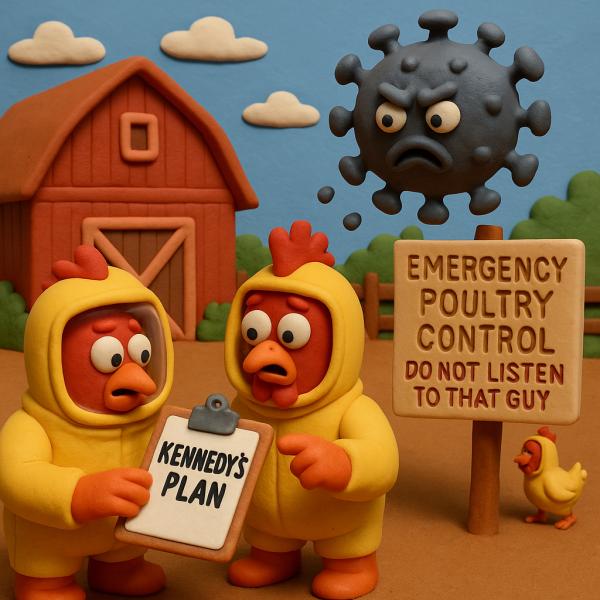
“I don’t want to seem like I’m being evasive, but I don’t think people should be taking medical advice from me.”
- HHS Secretary Robert Kennedy, Jr.
That’s refreshingly self-aware. As it turns out, people should not be taking veterinary advice either. When asked about how to handle the ongoing avian influenza epidemic, Kennedy said, as reported by the New York Times among other outlets, that farmers:
“…should consider maybe the possibility of letting it run through the flock so that we can identify the birds, and preserve the birds that are immune to it.”
At first glance, this might sound like natural selection with a public health twist. Fortunately, as the Times points out, these decisions will be made by the Secretary of Agriculture, Brooke Rollins. But let’s take just a moment to consider why Secretary Kennedy’s suggestion is so misguided, scientifically and economically.
Highly Pathogenic Avian Influenza (HPAI): More than the “flu”
Termed “bird flu,” the current H5N1 strain is neither mild nor manageable; it is extraordinarily lethal to poultry. To get a better sense of the scale of the problem in a country that has 1.5 billion chickens, consider the study completed by the USDA after the last bird flu epidemic in 2015. That epidemic, which is comparable, but smaller than our current concern, resulted in:
- Loss of 12% of layers (egg producing chickens), 8% of turkeys, but less than 0.01% of broiler chickens
- Egg production declined sharply, requiring nearly a year to recover. Turkey production followed a similar pattern. Egg and turkey prices rose, 61% and 17% respectively, while broiler prices fell by roughly 30%.
- Exports of eggs declined by 45%, turkey by 41%, and broilers by 18%. The broiler losses were not due to influenza directly, but rather to 50 importing countries being unwilling to bring possibly infected meat into their countries.
- Economic losses exceeded $ 1.3 billion.
- The federal government spent $200 million on indemnities for culled birds and an additional $679 million to mitigate market impacts on producers.
This historical context makes it abundantly clear: letting the virus “run its course” is not an exercise in resilience—it’s an invitation to catastrophe.
The False Hope of Herd Immunity
The mortality from bird flu ranges from 75% to 100% in chickens and turkeys. Ducks appear to be somewhat more resistant, but this resistance means they are often asymptomatic carriers, spreading the virus. Broiler chickens are just as susceptible, but with a roughly 6-week lifespan, they are just not around long enough to get sick.
To do as Secretary Kennedy suggests and just let it run wild will result in monumental economic losses to producers, consumers, and the federal government as it attempts to mitigate losses. It will result in a mass extermination of chickens, which should make even those with little concern over animal welfare shudder. The scale of illness would put chicken “first-responders,” the farmers and other workers involved in the care and upbringing, at increasing risk. Moreover, the more hosts the virus infects, the more opportunities it has to mutate. Letting it “run wild” is tantamount to giving a highly pathogenic virus millions of opportunities to become more contagious, even jumping species, to say, us.
Genetic Fantasy
But perhaps, finding those resistant chickens will be worth all the economic and welfare carnage. Alas, that too is a fantasy wrapped in scientific ignorance. As with many of our crops, layer chickens are almost a monoculture. Two companies provide layer chickens globally, just two. The odds that a few of these genetic “almost clones” might offer resistance robust enough to rebuild the industry are not just low, they're aspirational, bordering on delusional.
A representative of Secretary Kennedy indicated that his comments were aimed at those chicken first-responders that are currently involved in culling flocks with HPAI, where human exposure is currently the highest. Of course, letting it run wild would only increase the number of infected chickens and heighten the exposure. Secretary Kennedy’s representative indicated that “Culling is not the solution. Strong biosecurity is.”
The Government’s Public Health Response
Department of Agriculture Secretary Rollins has proposed $500 million for improved biosecurity to farms, with the government covering 75% of the costs. However, biosecurity measures are long-term or, at best, medium-term solutions. Culling, for which the Secretary has put aside $400 million, remains our best short-term solution. It’s brutal, but given our current “toolbox,” it’s necessary to protect the broader population of animals and people alike.
There is an additional $100 million for an HPAI vaccine and therapeutics for chickens. But as in many other instances, what the Administration says and does are often different. According to The Washington Post, the Administration fired the chief and other senior Food and Drug Administration veterinarians overseeing investigations for the bird flu response. Funding for the proposed human vaccine, if HPAI becomes infectious to humans, was canceled in May. Meanwhile, cattle, already a new host for HPAI, have seen their surveillance downgraded in favor of focusing solely on chickens.
When it comes to managing avian influenza, magical thinking and offhanded Darwinian experiments aren’t going to cut it. The path forward requires hard choices, not hopeful speculation. Secretary Kennedy was right about one thing: people shouldn’t be taking medical advice from him. Veterinary or epidemiological advice? Even less so.



